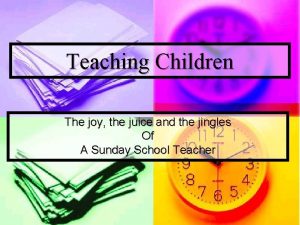A Review of Naturalistic Teaching Models for Children

- Slides: 1

A Review of Naturalistic Teaching Models for Children with Autism Matthew H. Newquist, Kevin Schlichenmeyer, and Kevin Klatt Psychology Department University of Wisconsin-Eau Claire Introduction Within Applied Behavior Analysis, several different naturalistic teaching models are used to teach skills to children with autism. These models include: Incidental Teaching (IT), Milieu Teaching (MT), Natural Language Paradigm (NLP), Pivotal Response Training (PRT), Enhanced Milieu Teaching (EMT), Prelinguistic Milieu Teaching (PMT), Multiple Incidental Teaching Sessions (MITS), and Speech and Play Enhancement for Autistic Kids (SPEAK). A review of these models is provided for readers to discern the similarities and differences of these models. Procedures Incidental Milieu NLP PRT EMT PMT MITS Reinforcement Contingent on Behavior x x x x Reinforcement Matches Stimuli x x x x Shared Control/ Child Choice or Initiation x x x x Prompt x x x x Shaping or Reinforce “Reasonable” Attempts x x x Clinician Models Response x x x Arrange Setting x x x Prompt Delay x x x Turn Taking x x Adult Confirms Behavior x x Task Variations/ Multiple Exemplars x x x Incidental Teaching Procedures x x x Teacher Asks for Verbal Expansion x x x Methods Teaching is Embedded in Ongoing Interactions x x x • The models were reviewed if they met the following a priori criteria: The theoretical orientation was behavioral, the model was published in a peer reviewed journal, and the procedures within each model were implemented in a natural setting (e. g. , home). Studies were identified by entering key words (teaching methods, teaching methods + autism, naturalistic teaching, naturalistic teaching models, & naturalistic teaching strategies) in several electronic search engines. • The procedures within each treatment model were reviewed to identify the specific characteristics of each model. • Two researchers independently reviewed the articles and compiled a list of procedures used in each teaching model. If a disagreement occurred, researchers reassessed the literature together and cited the procedure used. • Inter-rater agreement for the procedures of each model was calculated by dividing agreements by agreements plus disagreements and then multiplying by 100% {R = [A/(A+D)] x 100%}. Reliability for each of the models was as follows: IT 75%, MT 69%, NLP 73%, PRT 87. 5%, PMT 75%, EMT 56%, and MITS 75%. Mand Modeling x x Assess Skill Level x x Train Adults to Promote Integrity x x Child Cued Modeling x x Conduct Preference Assessment x x Interspersed Mastered Items x Obtain Child's Attention x Two Practice Trials x Clinician Repeats Modeled Phrase While Playing with Toy x Preferred Item Variation x Multiple Cues x Social Routine Building x Clinician Models an Expanded Request x Contingent Motor/Vocal Imitation x Linguistic Mapping x Elicitive Models Acknowledgements This research was supported by the Office of Research and Sponsored Programs at the University of Wisconsin-Eau Claire. We thank Kristina Vargo, Kelly Paulson and Rochelle Smits for their feedback and review of this study. Results • The seven behavioral treatment models reviewed and the procedures used within each model are listed in the table. • The results show that 33% of the procedures are unique to a specific model. By contrast, 73% of the procedures are used in 2 or more models (overlap). • The results also show that 53% of the procedures are used in 3 or more of the treatment models. • All models used the following procedures: reinforcement contingent on behavior, reinforcement matches stimuli, shared control, and prompt procedures. • The seven models reviewed all included at least 8 (27%) of the procedures. • The model which included the most procedures was EMT with 19 (63%). Discussion A preliminary search of the literature found eight naturalistic teaching models for treating children with autism. Seven of the models fulfilled the a priori criterion. SPEAK was not included because it had not been published in a peer reviewed journal. The included treatment models were further reviewed to identify 30 distinct procedures. One third of these procedures are unique to one particular model. Furthermore, many of the procedures are shared across several of the treatment models. The fact that inter-rater reliability was less than 80% for all of the models suggests that the procedures included in naturalistic teaching models need to be defined more clearly. Future research should investigate the scientific merit of each procedure and the combination of procedures (i. e. , models). Researchers might also map Skinner’s verbal operants to the procedures used in naturalistic teaching.

